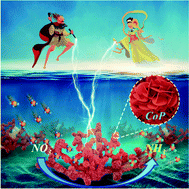Elucidating the activity, mechanism and application of selective electrosynthesis of ammonia from nitrate on cobalt phosphide†
Abstract
Electrochemical reduction of nitrate to ammonia (nitrate reduction reaction, NO3−RR) under ambient conditions, which overcomes the drawbacks of the energy-intensive Haber–Bosch reaction and low-efficient N2 electroreduction, is one of the alternatives toward ammonia-synthesis. In this study, cobalt phosphide nanosheet arrays (CoP NAs) grown on carbon fiber cloth (CFC) (CoP NAs/CFC) exhibit an ammonia-evolving rate of 9.56 mol h−1 m−2 (214.14 L h−1 m−2, STP) at −0.3 V vs. RHE with a Faraday efficiency of ∼100% under alkaline conditions, which goes far beyond the Haber–Bosch reaction. Phosphorus was proved to be crucial for stabilizing the active phase and optimizing the energy barriers of the NO3−RR. Moreover, operando X-ray absorption fine structure (XAFS) firstly revealed that Co 4p orbitals directly participate in the nitrate adsorption and electron transfer step of the NO3−RR. Eventually, combining the NO3−RR and benzyl alcohol oxidation reaction at the cathode and anode respectively, sustainable synthesis of value-added chemicals was successfully fulfilled.



 Please wait while we load your content...
Please wait while we load your content...